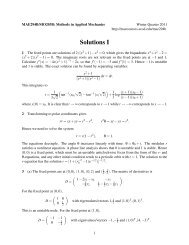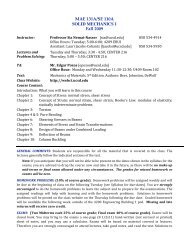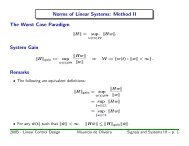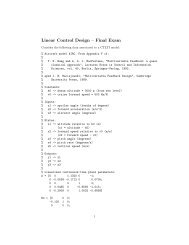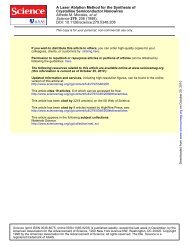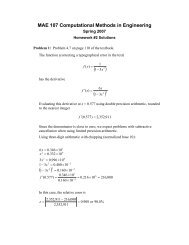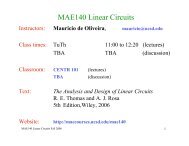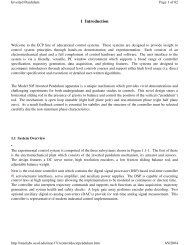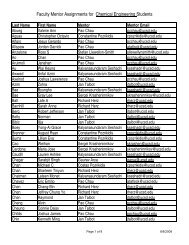solution
solution
solution
You also want an ePaper? Increase the reach of your titles
YUMPU automatically turns print PDFs into web optimized ePapers that Google loves.
ω = 100 . For low frequency ( ω ω 10 ), it’s a straight line with a slope of 0 at<br />
p<br />
p<br />
phase equals 0. For high frequency ( ω 10ω p ), it’s a straight line with a slope of 0 at<br />
phase equals − π . Then for frequencies between them ( ω 10 < ω < 10ω<br />
), the<br />
p p<br />
straight line (reference to log10 ω ) achieves the − π phase change, as shown (dotted<br />
line). Then, get the phase asymptote by applying composition rules: dashed line plus<br />
dotted line, as shown (solid line).<br />
phase factor<br />
phase factor<br />
Code:<br />
2<br />
0<br />
-2<br />
-4<br />
10 0<br />
2<br />
1<br />
0<br />
-1<br />
-2<br />
10 0<br />
10 1<br />
10 1<br />
clear all<br />
omg = 1:1:10000;<br />
asym_z = 20*log10(omg/500); % get the magnitude asymptote from zero<br />
figure(2),subplot(2,1,1),semilogx(omg,asym_z,'--'),hold on<br />
xlabel('\omega'),ylabel('gain factor')<br />
asym_z_ph = pi/2*ones(size(omg)); % get the phase asymptote from zero<br />
figure(3),subplot(2,1,1),semilogx(omg,asym_z_ph,'--'),hold on<br />
xlabel('\omega'),ylabel('phase factor')<br />
omg_p = 100;<br />
omg1 = 1:1:omg_p;<br />
10 2<br />
ω<br />
10 2<br />
ω<br />
10 3<br />
10 3<br />
10 4<br />
10 4



